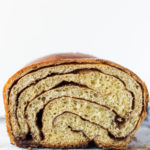cinnamon swirl yeast bread
This yeast bread is a caramelized, gooey swirl of cinnamon and sugar wrapped inside a tender, fluffy crumb.
- Yield: 1
- Category: Bread
- Cuisine: American
Ingredients
cinnamon swirl bread
- 1/2 cup + 1 tbsp (125 g) water, room temperature
- 4 (60 g) egg yolks
- 2 tbsp (25 g) canola oil
- 2 tbsp (40 g) honey
- 1 3/4 tsp (5 g) instant yeast (can substitute active dry yeast, just proof it first in the warm water with half of the honey)
- 1 1/2 tsp kosher salt
- 2 1/3 cups (325 g) all purpose flour
- 2 tsp ground cinnamon
- 2/3 cup (165 g) granulated sugar
- 3 tbsp melted butter or lard for brushing dough
egg wash
- 1 large egg
- 1 egg yolk
- 1 tbsp water
Instructions
directions
- Combine the water, egg yolks, oil, honey, yeast, salt and half of the flour. Using a wooden spoon, mix until a thick batter forms, then stir in the rest of the flour to form a shaggy dough. Turn out dough onto a floured work surface and knead for 6 to 8 minutes, or until smooth and elastic. If very sticky, add flour as needed, but use sparingly to keep the dough tender.
- Put the dough in a lightly oiled bowl, cover with plastic wrap, and let rise in a draft-free area for 1 hour. Combine the cinnamon and sugar in a small bowl.
- Create a parchment paper sling by cutting a piece of parchment approximately 8" x 13" in size and placing it in an 8”x4” metal loaf pan, allowing a few inches to hang over the long edges. Lightly grease parchment paper and exposed ends of pan with cooking spray or melted butter and set aside. (note: the parchment paper sling is not shown in the photos below, but it is very helpful in case sugar leaks out during baking and cements the bread to the pan)
- Place the dough on a well-floured surface and roll it out to a 13" x 15" rectangle. Arrange the dough so the long edge is parallel with the countertop and brush the entire surface with melted butter. Spread half the cinnamon sugar mixture across the buttered surface of the dough.
- Fold the long edges at the top and bottom of the dough so that they meet along the middle of the length of the rectangle. Brush the newly exposed surface with more melted butter and cover with half of the remaining cinnamon sugar.
- Take the left side of the dough and fold it two- thirds of the way over to the right. Brush butter onto the newly exposed surface and rub half of the remaining cinnamon sugar on it. Fold the right side of the dough over to the left. Turn the dough 90° counterclockwise. Brush the surface with melted butter and spread the remaining cinnamon sugar on this surface.
- Beginning at the side closest to you, roll the dough into a cylinder. Place the loaf with the seam side down in prepared loaf pan.
- Beat the egg, egg yolk, and water together in a small bowl and brush it on the loaf. Allow the dough to rise in a draft-free area for 1 1/2 to 2 hours, or until it has risen significantly in the loaf pan and partially springs back after touching it.
- Preheat oven to 335° F.
- When the dough has fully proofed, brush it again with egg wash and lightly score 3 slashes into the surface with a sharp knife. Bake for 15 minutes, then reduce the oven temperature to 320°F and bake for another 25 minutes, until the crust is deeply golden brown. If using a meat thermometer, remove the bread from the oven at 195° to 200° F. Let cool for at least 20 minutes before removing from the pan. If you've made it this far without tearing into the steamy, molten, sugary loaf-- nicely done. I didn't.
Notes
- makes one 4" x 8" loaf | recipe from Zingerman's Bakehouse
- This bread will be good for several days after baking, and even better toasted and buttered or made into a decadent french toast.
Nutrition
- Serving Size: 1/10th of loaf
- Calories: 264
- Sugar: 17g
- Sodium: 389mg
- Fat: 9.3g
- Saturated Fat: 3.4g
- Unsaturated Fat: 5.4g
- Trans Fat: 0.1g
- Carbohydrates: 40g
- Fiber: 1.3g
- Protein: 5.3g
- Cholesterol: 120mg
Find it online: https://www.withspice.com/blog/zingermans-cinnamon-swirl-bread/
